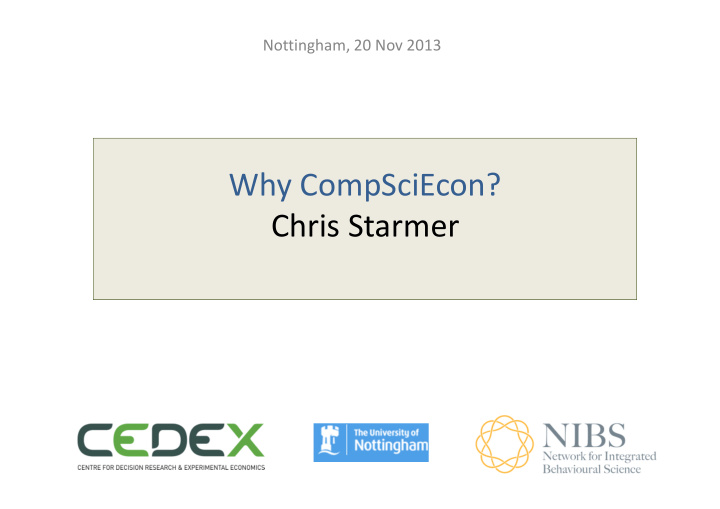



Nottingham, 20 Nov 2013 Why CompSciEcon? Chris Starmer
Simulation • Simulation techniques widely used in Econ: – e.g. Agent-based computational economics (ACE) • studies complex systems (whole economies) • dynamic systems of interacting agents • Rationality vs Bounded – Sometimes used to explore implications of rationality – Sometimes implements boundedly rational agents • Well-established traditions with high ranking specialist journals: – E.g. J. of Economic Dynamics and Control (JEDC)
What’s new? Peer-Olaf: emphasised (in part) possible novelty of specific modelling techniques (e.g. Unified Modelling Language). I don’t fully appreciate significance of this (!) My imagination captured by a particular methodological strategy Agent based modelling as bridge from lab to field:-
Experiments to map agents • Consider the public good paradigm: • Typical setup – Highly stylised (laboratory) decision environment – Attempts to capture ‘essence’ of a specific form of strategic dilemma • Individuals decide how much they will contribute to common good • Built in tension between individual payoff maximisation and social efficiency
Public Goods Experiments • Voluntary Contribution Mechanism – N Individuals; each allocated T tokens – divide between ‘private’ vs ‘public’ account • Public contributions raised by factor m • Each individual (i) receives payoff: π i = T – c i + (m/N).(∑contributions) • with 1 < m < N – full contribution (social optimum) – zero contribution (individual optimum)
Significance of lab research on PGs • Many experiments with variants of basic setup • Highly replicable regularities – Inconsistent with standard econ theory • For example in repeated PG game: Significant early stage contributions Sanctions matter: Contributions decay in absence of sanctions Contributions sustained (or enhanced) with sanctions
Unfinished business • Work underway to understand these patterns – e.g. characterising agents as stable behavioural ‘types’ (bounded rationality) • conditional co-operators, free riders etc. • Plenty of scope for further work here: – Range of types – Stability of types – More psychological agents • Hot/cold – Adaptive agents (learning) All about modelling behaviour of AGENT IN THE LAB – Role of anonymity – Impacts of time horizons
From lab to field • An exciting agenda? – Take agents “bottled” in the lab – Use ABM to consider the consequences of their behaviour in settings that can’t be readily studied in the lab • Examples in PG context: – Energy use in shared households – Uptake of vaccinations – Mechanisms to support charitable giving – ………..
Contrasting two approaches Make lab like world Use compscience modelling techniques to export lab • For example agents to more field-like – Frame a more or less ‘model’ environments. standard experiment as an energy consumption problem This is what I have in mind • Relies on agents being when I use the term able to ‘import’ relevant CompSciEcon behaviours to the lab context IS THIS NOVEL? – Behave in the lab as if it Well not completely of were the described world course: but significantly under explored (maybe??)
What makes it interesting? • Informing policy with experimental economics – exp. econ. methods have attraction of allowing relatively clean inferences re causal mechanisms that operate in lab • E.g. how are PG contributions affected by size of group, number interactions, scale of payoffs etc. – leap of faith typically required to know how far those mechanisms operate in more complex environments of interest • One standard way to explore this is by making the lab like the world…..
Trouble is……. Not at all clear where and when we are entitled to assume that the behavioural tendencies observed in the lab map to target environments of interest. Consider for example experiments related to: Tax evasion Honesty Corruption
ABM as complement to lab tools ABM as tool for exploring For purposes of implications of: • Testing external validity of • Lab-bottled agents in lab findings field-like environments – E.g. via fit with features of directly observable field behaviours • Exploring consequences of changes in environment – E.g. policy nudges
• In any application, to OK but….. begin with, we don’t but, an attraction of the • …for any given target approach is o something field behaviour: economic theorists can’t – E.g. energy conservation or won’t do grow complex agents with multiple • How do we know…. (tuneable) non-standard – Which behavioural features tendencies may be important? – Cooperativeness – Which structural – Shortsightedness features of the – Adaptability environment may be – Loss aversion important? – Non-linear attitudes to – Etc….. chance ……………
So get ready to vote three options
1. Reinventing the wheel?
2. Interesting idea but not feasible?
3. New space for behavioural science?
Recommend
More recommend